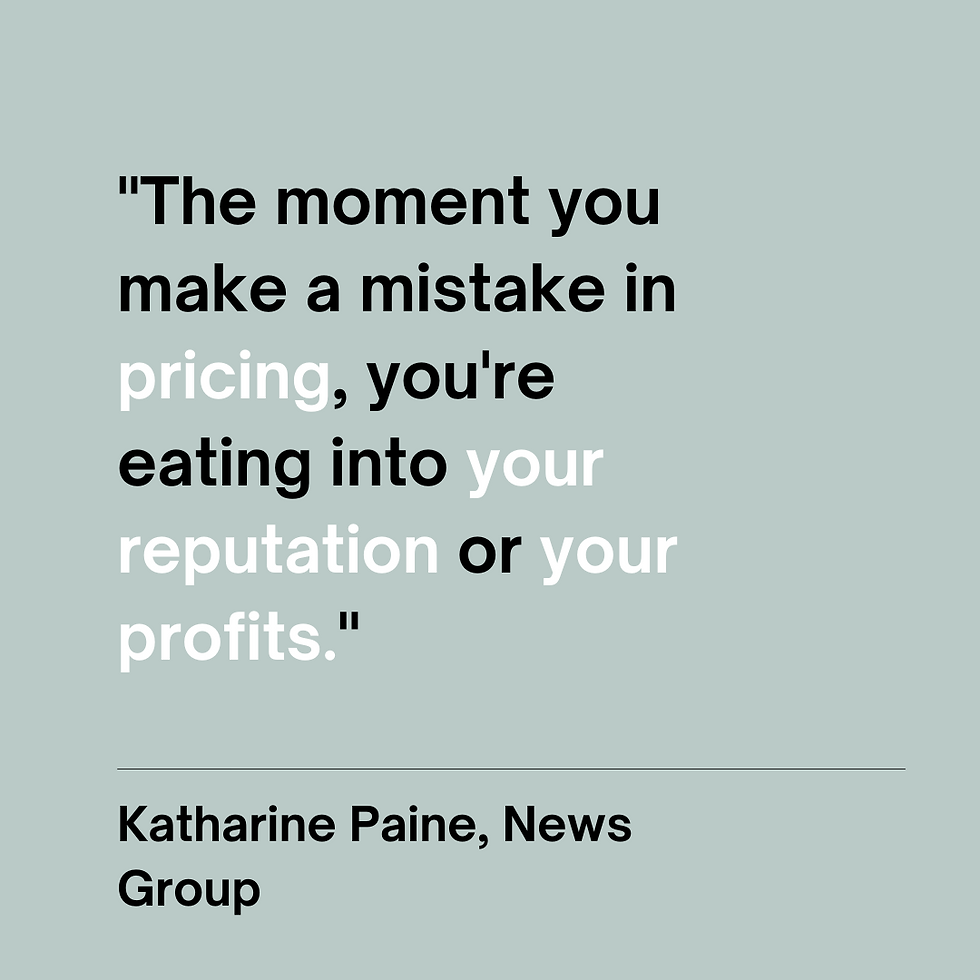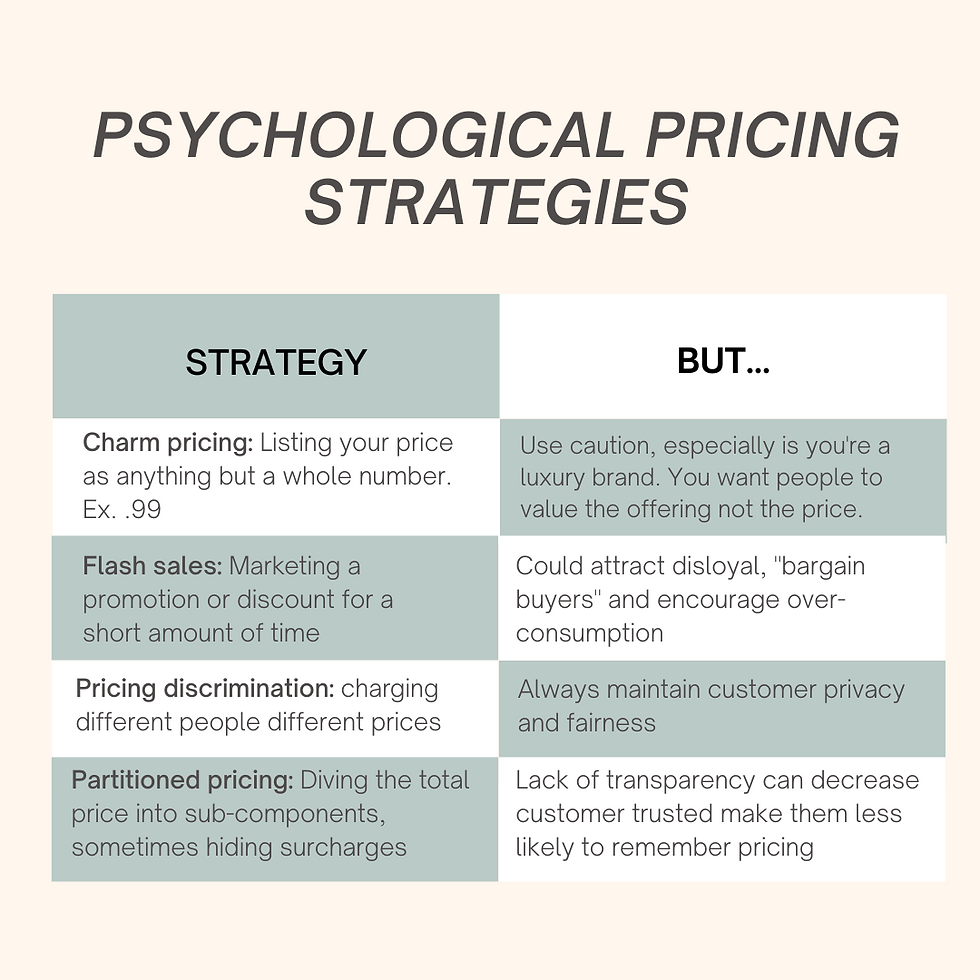Is Psychological Pricing Ethical?
- Sarah Bloodworth

- Jul 26, 2022
- 5 min read
Updated: Jul 14, 2024
Psychological pricing is aiming to create a subconscious, emotional impact on buying decisions.
A prime example of psychological pricing is using colour psychology in pricing visuals. It’s no secret that the way the mind perceives visuals can influence a sale.
For example, using the color red to indicate a sale, exclusive price, or “buy now” button is said to to increase sales by creating a sense of urgency.

Obviously psychological pricing can go into even more strategic, and perhaps dodgy areas.
Some businesses use inflated eco-imagery or wording to mislead the customer into perceiving a higher value of the product or service. Even if you’re a genuinely caring business owner, it can be like walking a tightrope to price your ethical product or service.
On one hand, you want to make your ethical alternative as available as possible by keeping your prices competitive. But on the other hand, eco businesses inevitably have more costs associated with them.
And the bottom line is the bottom line -- you want to feel like you’re making a worthwhile profit for your efforts.

In this case, psychology is a science you can inject into your pricing strategy. But are some of these strategies really ethical for especially a conscious business to use?
To be clear, I am not speaking to the legality of these strategies. For instance, while predatory pricing, or pricing extremely low to drive competitors out the market, is illegal in the U.S., it’s difficult to prove. So like many things in business, it’s a grey area.
Here are some of the four most common types of psychological pricing strategies, an analysis of their effectiveness, and an analysis of their ethics, which is ultimately up to you to decide.
4 Common Types of Psychological Pricing Strategies

1. Charm Pricing
One of the most common and well-known strategies in psychological pricing is called “charm pricing,” or listing your price as anything but a whole number to create the impression that it costs less.
Examples: .99 cents, $4.99, etc.
Charm Pricing: Does it Really Work? Depends on what you're selling.
According to Business.com, “A wide body of research has confirmed that the magic of nines, or charm pricing, is due to the fact that consumers read from left to right with precipitously decreasing attention.”
For example, a customer would see $99.99 as $99 rather than $100.
Some say it could be quite purposefully misleading, although the perceived savings of a penny isn’t exactly the most evil thing imaginable.
This strategy also works in bigger markets, like housing. The more precisely a seller listed a home (say $600,439), the more quickly it sold. But of course, none of these strategies are guaranteed to work on their own, and depends on the customer, the market, and other aspects of the brand.
For instance, if you sell luxury or higher-values offerings, you probably won’t want to use charm pricing. That’s because you want people to value the product itself, not the price.
Michael Joseph, founder of Sustainable Savings, said it also depends on what type of business model you have.
“I don’t use a .99 model because it's more of a one on one (outreach and pitching to potential clients),” he said. “Other businesses that use this are likely feed from online advertising, where the customer is deciding to buy on their own.”
2.Flash Sales
Flash sales, or creating a sense of urgency by marketing a promotion or discount for only a short amount of time, can be an effective way to price your products low with high ROI (Return on Investment).
Oftentimes, businesses will dramatise the sale to create even more of a psychological urgency effect. For example “Low Stock” might mean hundreds of thousands of units that didn’t sell well last quarter.
Not to mention that unsuccessful flash sales can hurt brand image, create massive profit loss, and/or attract disloyal, one-time-only customers.
Flash Sales: Does it Really Work? YES! SO ACT NOW!
Flash sales generate an average 35% lift in online transaction rates. The reasons for this is simple - our brains are thrill seekers.
According to Psychology Today, “The idea of competing with other shoppers inspires a sense of urgency and excitement that's often accompanied by autonomic nervous system arousal which clouds thinking.”
3.Pricing Discrimination
Pricing Discrimination can be a common practice among freelancers or "soloprenuers" because it is easier to do when you’re working with clients/customers on a more individual basis.
In “pure” price discrimination, the seller charges customers the maximum price they are willing to pay, even if it is for the same offering. In more common forms of price discrimination, the seller charges different groups of customers different prices.
There’s no doubt that charging higher prices for the sake of discriminating AGAINST certain genders, races, or sexualities is unethical. But there are so many different types of pricing discrimination.

Pricing Discrimination: Does it Really Work? Yes, but be sensitive.
The benefits of pricing discrimination is that it can offer different choices for your customers, and cut prices for groups of consumers who are sensitive to prices (elastic demand).
But put plainly and simply - customers want to be treated fairly.
So if one of your clients finds out they’re paying more than another, then that’s bad business. But in reality, it’s more of an ethical decision on your part then a true PR issue.
Privacy is another issue.
The idea that businesses can determine your age, location, etc. and adjust your pricing based on that is a little unsettling to some. Of course, the tech-savvy ones can get around the system by changing their IP addresses.
4.Partitioned Pricing Strategy, hiding the extra costs
A Partitioned Pricing Strategy is when a seller divides the total product/service price into different components – a base price and surcharges including shipping and handling, taxes, and other fees. Sometimes businesses will purposefully hide the surcharges to come off as more competitive than they truly are.
Partitioned Pricing Strategy: Does it Really Work? Yes, but do so transparently.
A study found that around that partitioned prices decrease consumers' recalled total costs and increase their demand. However, when brands aren’t transparent about surcharges, this can create a negative affect, which in turn unfavourably influences brand attitude.
So, being sneaky sneaky about the extra costs may not be effective in the long-run.
At the end of the day, pricing your product or service won’t come down to any of these techniques on their own.
Providing a meaningful solution to your customer’s problem is going to make the sale, and determine the value of your product.
Alexis Stephanos, thought leader on psychological business principles, said being eco-conscious is not even enough to value your product or service higher.
“One of the biggest mistakes entrepreneurs make is thinking just because their products (or services) are eco friendly, that they are providing value by default,” Alexis said. “The positioning needs to be combined with the solution. Simple marketing tricks on their own don’t work.”



Comments